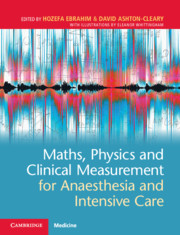Book contents
- Maths, Physics and Clinical Measurement for Anaesthesia and Intensive Care
- Maths, Physics and Clinical Measurement for Anaesthesia and Intensive Care
- Copyright page
- Dedication
- Contents
- List of contributors
- Preface
- Acknowledgements
- Abbreviations
- Chapter 1 Data Analysis and Medical Statistics
- Chapter 2 Basic Physics and Electronics
- Chapter 3 Heat, Temperature and Humidity
- Chapter 4 Behaviour of Fluids
- Chapter 5 Gas Measurement and Supply
- Chapter 6 Gas Concentration Measurement
- Chapter 7 Blood Gas Analysis
- Chapter 8 Vapours and Vaporizers
- Chapter 9 Ventilators and Breathing Systems
- Chapter 10 Safety in the Clinical Environment
- Chapter 11 Blood Pressure Measurement
- Chapter 12 Cardiac Output Monitoring
- Chapter 13 Cardiac Support Equipment
- Chapter 14 Ultrasound and Doppler
- Chapter 15 Atomic Structure, Radiation, Imaging and Lasers
- Chapter 16 Electro-biophysiology
- Index
- References
Chapter 16 - Electro-biophysiology
Published online by Cambridge University Press: 30 August 2019
- Maths, Physics and Clinical Measurement for Anaesthesia and Intensive Care
- Maths, Physics and Clinical Measurement for Anaesthesia and Intensive Care
- Copyright page
- Dedication
- Contents
- List of contributors
- Preface
- Acknowledgements
- Abbreviations
- Chapter 1 Data Analysis and Medical Statistics
- Chapter 2 Basic Physics and Electronics
- Chapter 3 Heat, Temperature and Humidity
- Chapter 4 Behaviour of Fluids
- Chapter 5 Gas Measurement and Supply
- Chapter 6 Gas Concentration Measurement
- Chapter 7 Blood Gas Analysis
- Chapter 8 Vapours and Vaporizers
- Chapter 9 Ventilators and Breathing Systems
- Chapter 10 Safety in the Clinical Environment
- Chapter 11 Blood Pressure Measurement
- Chapter 12 Cardiac Output Monitoring
- Chapter 13 Cardiac Support Equipment
- Chapter 14 Ultrasound and Doppler
- Chapter 15 Atomic Structure, Radiation, Imaging and Lasers
- Chapter 16 Electro-biophysiology
- Index
- References
Summary
A 51-year-old male is admitted via the emergency department after suffering a cardiac arrest and a resulting head injury when he collapsed. Despite arriving in hospital with a stable circulation, he is agitated and very confused. His ECG shows changes consistent with an anterolateral infarction and a CT head does not show any abnormality. He is anaesthetized, undergoes an angioplasty and is admitted to critical care. After failed sedation holds the next day, a CT head is repeated and an EEG is also obtained. The imaging demonstrates cerebral oedema and the EEG shows seizure activity. These are treated medically for a few days and the patient’s consciousness improves. However, during this time, he develops ventilator-associated pneumonia, requiring ventilation for a further week. After this, despite improved neurology, there is difficulty in weaning the patient off the ventilator. He is investigated for critical illness weakness and nerve conduction studies. Electromyography confirms critical illness myopathy. With supportive management and appropriate rehabilitation, he eventually recovers.
- Type
- Chapter
- Information
- Publisher: Cambridge University PressPrint publication year: 2019



